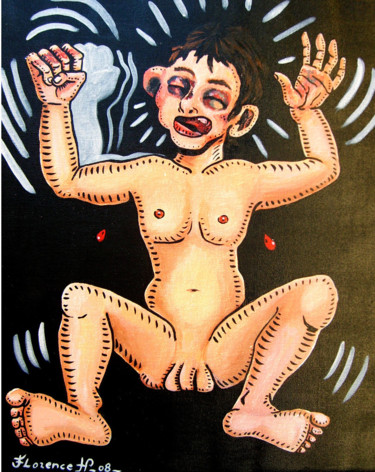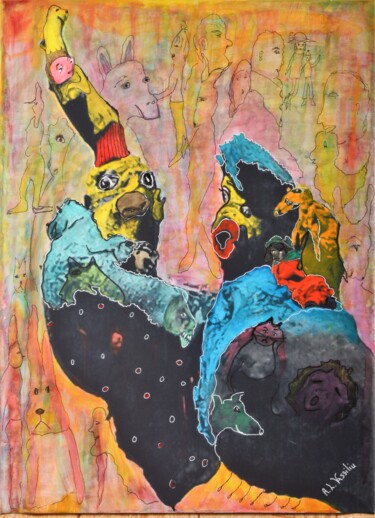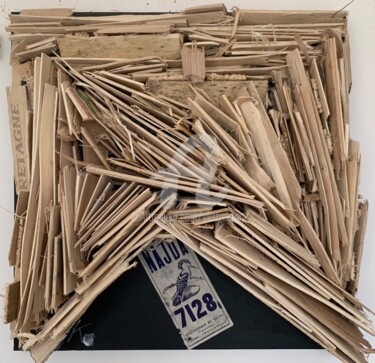 Igor Gadreaud (Gad the Brand), Hybrid antivirus mask V4.0, 2020. Sculpture, 60 x 25 x 35cm / 6.50 kg.
Igor Gadreaud (Gad the Brand), Hybrid antivirus mask V4.0, 2020. Sculpture, 60 x 25 x 35cm / 6.50 kg.
"True art is where no one expects it, where no one thinks about it or utters its name. Art is above all vision, and vision, many times, has nothing in common with intelligence nor with the logic of ideas".
Jean Dubuffet's iconic words are perfect to introduce to the concept of Art brut, an artistic movement also referred to as Outsider art, which, in recent years, has found enormous success within art events, fairs and auctions, thus becoming part of important collections scattered a bit all over the world. Unfortunately, however, it is not always easy to be able to classify this type of creative production, as it is often, and somewhat reductively, juxtaposed with Naïf Art, folk art or the work of simply self-taught artists. In addition, the contemporary world tends to relegate the aforementioned movement to a kind of "limbo," in which are included all those modes of expression, which are outside the more "mainstream" creative forms. Although this is a great misunderstanding, it is true that outsider works tend to transcend from other genres, as they are marked by rather eccentric visions, aimed at challenging the more traditional perception of art. Justifying this cliché is the fact that Outsider art initially emerged from the study of the works of psychiatric patients, who were capable of creating extremely pure and naive forms, the result of sincere, instinctive and unbiased intuition. However, it is not psychosis that determines membership in the movement, for it, assuming there is one, must be combined with a self-taught training, capable of departing from the canonical standards and classifications of the artistic world. In addition, it is necessary for the will to create to eschew the desire for visibility and the desire to adhere to public taste or dominant aesthetic trends. Indeed, art brut artists must create by simply giving vent to their innermost emotions, without imagining that their work can be shared with others and, consequently, standardized.
 Vaxo Lang, Without oxygen, 2022. Acrylic on canvas, 40 x 40 cm.
Vaxo Lang, Without oxygen, 2022. Acrylic on canvas, 40 x 40 cm.
 Eric Bertrand, Job, 2021. Acrylic on canvas, 150 x 150 cm.
Eric Bertrand, Job, 2021. Acrylic on canvas, 150 x 150 cm.
Outsider art: the origins
"For me, madness is super sanity. Normal is psychotic. Normal means lack of imagination, lack of creativity."
Jean Dubuffet
The term "Outsider Art," coined in 1972 by British writer and art historian Roger Cardinal, essentially arose to be understood as the English-language equivalent of the older French word "Art Brut." In fact, going back in time, the word Art brut was invented by the painter Jean Dubuffet in 1945, pursuing the aim of bringing together under his name all those types of artistic production made by self-taught and/or psychiatric hospital patients, distinguished by a marked ability to operate by eschewing canonical aesthetic convictions. In this context, it emerges forcefully how Art brut, a movement aimed at giving voice to a previously unheard of art form, also represents an ideological trend, which favored the demolition of all sorts of creative discrimination. In fact, if previously artistic activity was always attributed to the upper echelon of society, that is, the educated and "sane," capable of reflecting the canons of beauty and form, with Art brut, flair became decidedly more inclusive. It was Dubuffet himself who took the lead in attempting to break down the pillars of traditional aesthetics, stating that art is an instinctive and primary need, made by ordinary men, who no longer need to be either "superior" or geniuses. But how did Dubuffet's idea to give voice to psychologically fragile people as well come about? The French artist was largely influenced by the work of two psychiatrists, namely Walter Morgenthaler and Hans Prinzhorn, who, having been fascinated by the artistic production of their patients, analyzed, collected and documented it. Dubuffet, having come into contact with these studies, was completely fascinated by them, so much so that he believed that the art of the mentally ill could represent the purest form of artistic creation.
 Maximilien Dhumerelle (Max Dhum), Look away, 2022. Acrylic / marker on canvas, 100 x 80 cm.
Maximilien Dhumerelle (Max Dhum), Look away, 2022. Acrylic / marker on canvas, 100 x 80 cm.
 Patrick Santus, The trotinette of Pompei, 2005. Acrylic / pencil / graphite / marker / pastel on linen canvas, 180 x 180 cm.
Patrick Santus, The trotinette of Pompei, 2005. Acrylic / pencil / graphite / marker / pastel on linen canvas, 180 x 180 cm.
Outsider art in the artworks of the artists of Artmajeur
The fascination of the unconscious, of suffering, of the innermost fears and frustrations, but also the most genuine and carefree desire to express one's inner self, without adhering to pre-established rules and artistic genres, has also fascinated the artists of Artmajeur, who, as if they had become children again, have managed to reveal in a genuine, free and courageous way the most unmentionable motions of their soul. The outsider artists in our gallery are brought together within a broad "label," aimed at collecting not only self-taught and extremely sensitive artists, but also those who more simply, break through the mold of art tradition by showing their personal point of view. Among them, we can bring for example Patrick Jannin, Frob and Hanna Chroboczek, painters and draftsmen with an unprecedented perception of the real datum.
Michel Nedjar, Untitled, 1983 approx. Mixed media, 96.52 x 55.88 x 27.94 cm.
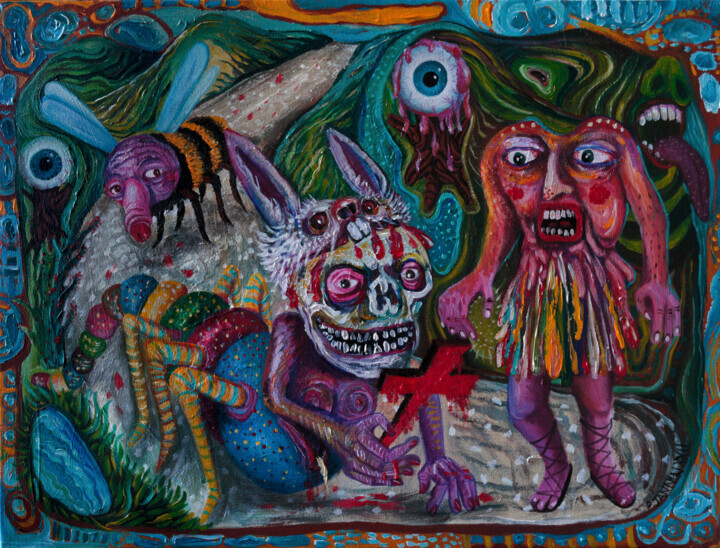 Patrick Jannin, All roads lead to Golgotha, 2022. Acrylic on canvas, 46 x 61 cm.
Patrick Jannin, All roads lead to Golgotha, 2022. Acrylic on canvas, 46 x 61 cm.
Patrick Jannin: All roads lead to Golgotha
All roads lead to Golgotha, an acrylic on canvas dated 2022, perfectly sums up the outsider stylings of Patrick Jannin, a French artist born in 1971, whose worldview is characterized by a strong, strange and extremely deep-rooted underlying restlessness. This feeling, on the fringes of traditional artistic fashions and currents, is expressed through the creation of a parallel reality, animated by strange and dark characters. Within this world, the artist's desire seems to be to want to denounce the baseness of human society, now condemned to a perpetual hell. Pursuing this end, the works of the artist from Artmajeur turn out to be true revelations about the dramas of current events, decipherable only by the eyes of attentive observers. Speaking of the art-historical tradition, akin to Jannin's work are a number of "monstrous" creations by Michel Nedjar, a French visual artist and experimental filmmaker, who, beginning in the 1970s, devoted himself to producing fetish dolls from pieces of fabric, rags and plastic bags, further customizing them with feathers, wood, straw, string and shells.
 Frob, Lifestyle, 2022. Acrylic / marker on canvas, 40 x 120 cm.
Frob, Lifestyle, 2022. Acrylic / marker on canvas, 40 x 120 cm.
Frob: Lifestyle
Lifestyle is an artwork by Frob, a contemporary French painter and sculptor whose work combines abstraction, Pop art and graffiti in a unique and original way. The juxtaposition of this artist with Outsider art could also esse considered far-fetched, but it seems quite probable if one looks at L'Hourloupe, a series of works created by the father of Art Brut, Dubuffet, beginning in the early 1960s. L'Hourloupe was born from the inspiration the French master drew from a doodle created while he was on the telephone, in which the fluid movement of line combined with limited fields of color to create dynamism. Precisely according to Dubuffet, this style evokes the way objects appear instinctively and unconsciously in the mind. In this context of free expression of the motions of the soul, the interwoven lines and characters of Lifestyle also fit well.
 Hanna Chroboczek, Girl and small characters on yellow table, 2021. Ink on paper, 67 x 52 cm.
Hanna Chroboczek, Girl and small characters on yellow table, 2021. Ink on paper, 67 x 52 cm.
Hanna Chroboczek: Girl and small characters on yellow table
Hanna Chroboczek's meticulous drawing immortalizes a little girl, who is intent on observing, and directing, the games of small characters arranged on a desk. Such a poetic and imaginative work, made with ink and markers, well summarizes the artist's highly personal figurative research, mostly marked by the presence of women, or little girls, who, in everyday situations, appear extremely sweet and adorable. Returning to Girl and small characters on yellow table, the slightly deformed face of the protagonist and the black, white and yellow color scheme seem to recall the iconic Dream, a drawing by the well-known Art brut exponent Vojislav Jakić. It is precisely the latter masterpiece that is characterized by a stylized presentation, in which similar male figures are multiplied, which are accompanied by animals and other small characters, immersed in a shimmering yellow background.

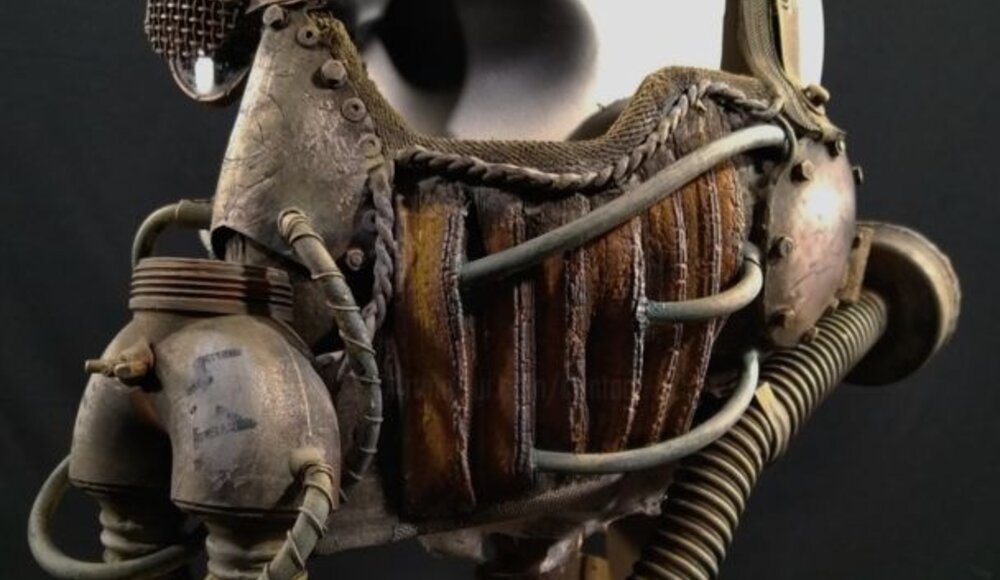
 Olimpia Gaia Martinelli
Olimpia Gaia Martinelli




